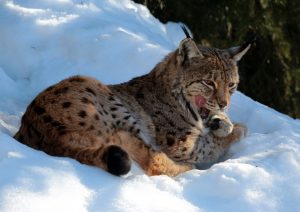The Eurasian lynx – a big cat about the size of a large dog – could soon be living in the wild in Kielder Forest, Northumberland.
The animal, which became extinct in Britain due to being hunted for its fur, may be reintroduced thanks to pressure from the Lynx UK Trust.
The Trust plans to make an application to introduce six lynx into the forest following two years of consultations with locals.
The Trust believes Kielder Forest would be a good home for the cats due to its lack of busy roads and its large number of deer, which are the lynx’s favourite food.
Shy of humans, Eurasian lynx are between 80 and 130 centimetres in length and 60 to 75 centimetres in height. Like domestic cats, they mew, hiss, growl and purr.
Lynx can hunt rabbits, hares, squirrels, foxes and mice as well as various species of deer. There is no record of lynx attacking humans.
The Kielder reintroduction plans are, however, opposed by sheep farmers and some other local residents.
The chief scientific advisor to the Lynx UK Trust, Dr Paul O’Donoghue, said, “Lynx belong here as much as hedgehogs, badgers, robins, blackbirds – they are an intrinsic part of the UK environment.”
“There is a moral obligation. We killed every single last one of them for the fur trade. That’s a wrong we have to right.”
Dr O’Donoghue claimed the lynx would be good for Kielder Forest’s environment as they would limit overgrazing by deer. He also claimed that the creatures could boost the local economy due to ecotourism.
Dr O’Donoghue said, “Lynx have already been reintroduced in the Harz Mountains in Germany. Now it is a thriving ecotourism destination and we thought we could do exactly the same for Kielder.”
The Lynx UK Trust plans to release four female and two male lynx into the forest. The animals would be microchipped and they would be reintroduced as part of an initial trial lasting five years.

The Chief Executive of the National Sheep Association, Phil Stocker, said, “Even if compensation were offered, it would not make sheep mortalities acceptable.”
“I cannot see how distressing attacks by a wild animal will be accepted by the public.”
Dr O’Donoghue argues, however, that lynx attacks on sheep are rare and that, on average, wild lynx only kill one sheep every two-and-a-half years.
The Lynx UK Trust plans to submit its application to Natural England within the next few weeks. If the application is accepted, the Trust says that lynx could be roaming wild in Kielder Forest before the end of the year.
Though the lynx was the last big cat in Britain to become extinct, there have been sightings of big cats – including pumas and lynx – in the UK in recent decades.
These animals are thought to have escaped from private collectors or been released into the wild by owners no longer able to care for them.
Kielder Forest, which began to be planted in the 1920s, is the largest manmade woodland in England. It surrounds the lake of Kielder Water, which was created by damming the North Tyne.
(Featured image courtesy of dogrando, from Flickr Creative Commons)




















